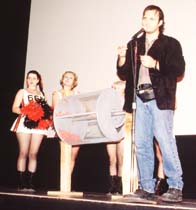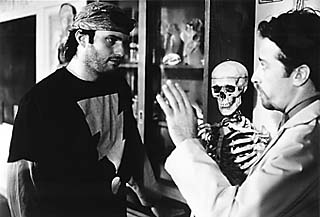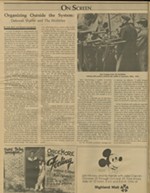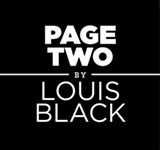Cozying Up to The Faculty
By Louis Black, Fri., Dec. 25, 1998
|
|
Rodriguez is explaining that at the end of the film there will be a raffle, the winner to receive the GTO used in the film. He suggests that the audience go nuts every time the car appears onscreen to show they really want it. This just amps up the crowd's enthusiasm. Only half-facetiously, Rick Linklater, who already owns a GTO, says he hopes he wins.
The house is shaking and rocking with applause and once the movie starts, cheers and screams. There are lots of screams.
The story, for me, started a few months back when Tommy Nix, (aka The Nixer, see Roadracer), e-mailed me to see if I wanted to be in the then-still-untitled movie. A few weeks later in the wee morning hours, I found myself headed to a warehouse in South Austin off of I-35. As instructed, I'd brought a couple of changes of clothing of the kind a schoolteacher might wear. I'd also brought proofs of Jack Jackson's new graphic novel Lost Cause to read (for those who regularly read the Chronicle, I'm trying to get at the pathos of this moment).
Shortly after arriving, I encountered Harry Knowles being made-up by the charming make-up artists. As always, we picked up where we had last left off, right in the middle of a conversation begun two decades ago when he was five and I in my late 20s. Wandering around we talked about Robert and the movie. Harry told several stories, one about Robert calling him at 2am (Nosferatu-like, neither one sleeps much at night), and tormenting him with the information that he was cooking a steak. According to Harry, Robert held the phone so close to the steak you could hear it sizzle.
Getting there early for a shoot means nothing: film calls are always early. Film production is not simply hurry up and wait, the whole process is geared toward extreme preparation -- having what will be needed on hand long before it is needed. This is especially true of extras. I have shown up at 6am to be used at 5pm. Veterans, we expected to be there awhile and wandered around in no rush. George Huang, director of Swimming With Sharks, was there. Harry and I hung with him a lot because he laughs at anything.
This was, however, a Rodriguez set, where the film was already finished in Robert's head, just needing to be shot, and where making a movie was a form of physical poetry. Within a very short period of time, we were on the set in the middle of the warehouse. Eerily, the set looked exactly like high school -- the walls, the doors, the lockers, the rooms. The faculty lounge reminded me of the one in the Bellows Falls, Vermont school where I student taught seventh and eighth grade in the early Seventies. It seemed almost the same, even the actors and extras playing teachers seemed all too familiar.
In the faculty lounge, we got ready for the scene. In it, film teacher Knowles is having his hand bandaged by school nurse Salma Hayek, who is being hit on by science teacher Jon Stewart. After a while, timid English teacher Famke Janssen walks into the room, while I sit on the couch doing a crossword puzzle as brilliant set designer Cary White, playing another teacher, lurks in the background. Rodriguez walked us through the scene several times, then we were sent off while he and the crew got ready to shoot, setting up lights, plotting the camera course, checking the set, and preparing sound. Harry and I went off to find George and make him laugh.
Watching Robert work, so confident, so in charge, so graceful in his motions, I thought back to 1989 when I was a judge at a regional film competition (along with Austin Chronicle intern Eli Kooris' mother Laura). We spent the day watching generic film school output -- editing and camera movement galore but precious little articulated camerawork (in which the visual exercises actually have something to do with the content of the film). At the end of the day, having watched many, many high production value yet relatively boring films, we watched this video.
Homemade, almost an anti-graduate-student-work, it blew everything else away. It stunk of film -- cutting, angles, sound, action, plot, theme, a deeply crazy poetry of pure cinema. Robert Rodriguez's Austin Stories, three short vignettes starring brothers and sisters, shot with the family video camera and edited on the family's two antiquated video decks, didn't just win, it hands-down beat everything else.
Rodriguez was already kind of a campus celebrity because of his wonderful Los Hooligans comic strip (The Texan, having launched Berke Breathed and Sam Hurt, has inspired more bad comic strips than Helen of Troy did ships; Los Hooligans was an exception). He had tried to get into University of Texas RTF classes, but his grades weren't good enough. After winning, he went to Steven Mims, who was then teaching film at UT, and said, "I beat your students; now can I get into the program?" Mims got him in. Rodriguez's Film One project was an extraordinary short, Bedhead, a continuation of Austin Stories, its family-oriented humor indicates fertile narrative ground that Rodriguez has yet to explore in his features.
During summer break, Rodriguez and his friend Carlos Gallardo decided to shoot a low-budget feature in Acuna, Mexico (where they had shot short-action films on video before) and sell it for a Spanish-language video release. Rodriguez entered a month-long drug research program, intending to write a movie using a list of what was available to him as a filmmaker -- a bulldog, a jail, buses, guitars, and automatic weapons. Over the years he had spent a lot of time with Gallardo, whose family was a force in Acuna (across the river from Del Rio), so Robert knew the resources available. The money from the drug test went for his share of production costs and, during the stay, he wrote the El Mariachi script (keeping the list in mind). The guy in the next bed was cast as the villain. Everything prepared, they went and shot El Mariachi for $7,000.
|
|
Visiting friends in L.A., Rodriguez dropped off Bedhead and a trailer he had cut for El Mariachi to Robert Newman, a prominent ICM agent. The first call Rodriguez got was for another copy; the machine ate the first one. The second call was to say that when he finished the film, Newman would rep it. Sony bought the $7,000 film for about a million (it cost hundreds of thousands more to get the film ready for distribution). They also gave him money for Desperado, a sequel to El Mariachi, and Robert Rodriguez was on his way to becoming a legend of low-budget/no-budget filmmaking.
In a white Cadillac, John Sayles, Maggie Renzi, Paul Miller, and I crossed the border from Del Rio to Acuna to the old (but still working) Boystown to visit the set of Desperado. We walked on the set and at first couldn't figure out which figure was Rodriguez. Then we realized he was the one lying on the ground operating a ground-level camera. Elizabeth roamed the set shooting documentary footage with a video camera.
The set looked like a Hollywood version of how a movie is made with smooth-flowing activity instead of the iceberg pace of most productions. As Rodriguez ran a three-camera shoot of a limo being hit by a missile, off to the side they set up and rehearsed a man being shot off a roof. The johns started arriving at Boystown, they'd get a beer and come out to watch. After a couple of hours we headed out; it was vacation and Sayles noted that butchers on vacation don't visit butcher shops.
Rodriguez followed Desperado with the Showtime movie Roadracers,his segment of Four Rooms, and From Dusk Till Dawn, which was written by and co-stars Quentin Tarantino. The Film Society sponsored a riotous premiere of From Dusk Till Dawn at the Paramount, but Robert and Elizabeth couldn't make it (Quentin Tarantino hosted).
Back on the set, they called us to shoot the scene. I sat on the couch doing a crossword puzzle. I had one line, "What is a five-letter word for stingy?" The Chronicle staff loved this, thinking it somehow appropriate. My line didn't make it to the movie.
Most sets move slowly. The director consults with crew and cast, but the actions usually associated with him are actually performed by the first assistant director. Rodriguez was all over the set, walking the camera movement, checking the video, actually operating the camera. Elizabeth glided through, laughing and making sure extras were treated as guests. The shoot went very quickly. This was a director and crew who knew what they wanted. The day, though long, was too soon over.
A couple of weeks later, Rick Linklater and I visited the set just to hang out. There was the same relaxed frenzy, Robert, relaxed but wired, was taking breaks and walking around playing guitar.
An Austin audience at the Paramount is a peak experience for a filmmaker. As director Jonathan Demme told producer Peter Saraf after the screening of Storefront Hitchcock, "This is the exact audience for whom we made this film."
Rodriguez is clearly thrilled to be presenting this film to an Austin audience. He fought to have this screening happen on this day at this theatre in this town. He is rewarded with a wildly enthusiastic audience.
The physicality of Rodriguez's directorial style comes across in the film; you feel it as well as see and hear it (two sound technicians from George Lucas' Skywalker Ranch flew in to get the Paramount's sound system just right). I'm in the movie, so my judgment is suspect, but what a terrific ride. It is such a pleasure to watch the way Rodriguez moves the camera, directs actors and cuts and then ties it all together with a brilliant soundtrack. The film whooshes around you. Later, after it's over, both Robert and Elizabeth are reluctant to leave the theatre. They stand there, talking to whomever, relishing the audience's joy at their movie.










